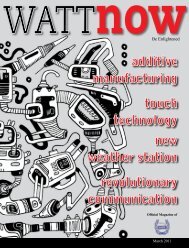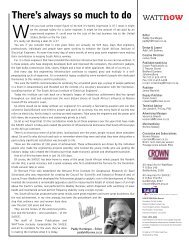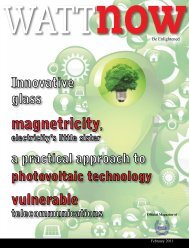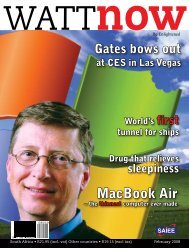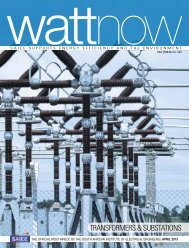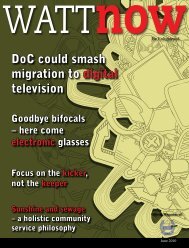Cut electricity consumption with automation - Watt Now Magazine
Cut electricity consumption with automation - Watt Now Magazine
Cut electricity consumption with automation - Watt Now Magazine
You also want an ePaper? Increase the reach of your titles
YUMPU automatically turns print PDFs into web optimized ePapers that Google loves.
<strong>Now</strong> you can build an<br />
entire machine on a<br />
microchip - and it works<br />
By Peter Middleton<br />
Micro-electro-mechanical systems or MEMS — also<br />
known as micromachines in Japan or micro systems<br />
technology (MST) in Europe – uses minute components,<br />
typically between one and one hundred microns for<br />
devices that range from twenty microns to one millimetre.<br />
MEMS is the integration of mechanical elements, sensors, actuators,<br />
and electronics onto a common silicon substrate through modern<br />
micro-manufacturing. The technology — based on the technology<br />
developed for integrated circuits (ICs) — places moving mechanical<br />
mechanisms on the same chips and on the same scale as their electronic<br />
controllers. It is a way of making complex electromechanical systems<br />
using batch fabrication methods similar to those used for ICs, but<br />
merging the electromechanical elements <strong>with</strong> the electronics.<br />
MEMS accelerometers are quickly replacing the conventional<br />
bulky devices used for air-bag systems in motorcars — because they<br />
are much smaller, more functional, lighter, more reliable, and are<br />
produced at a fraction of the cost. They are used for communications<br />
devices, electrical components<br />
such as inductors and tunable<br />
capacitors and mechanical<br />
micro-switches, which have<br />
huge potential in various<br />
microwave circuits. MEMS<br />
biochips are also being used<br />
for the detection of hazardous<br />
chemical and biological agents<br />
and in micro-systems for highthroughput<br />
drug screening and<br />
selection.<br />
In a paper presented at<br />
the recent 9th international<br />
tribology conference held<br />
in Pretoria, Professor John<br />
Williams of the Cambridge<br />
University Engineering<br />
Department, described one<br />
of the more spectacular<br />
MEMS applications, The Texas<br />
Instrument Digital Micro-mirror Device. It consists of an array of<br />
microscopically small, square aluminium mirrors — totalling more<br />
than half a million — in an area of about 1,5 square centimetres.<br />
Each mirror is approximately 20 μm by 20 μm and corresponds<br />
to a single pixel on a projected display: Each can be individually<br />
addressed and rotated about one or other of its diagonals through an<br />
angle of about 20° at a frequency of more than 100 kHz. These are<br />
now routinely used in data-projectors.<br />
Williams went on to describe the range of micro-actuators for<br />
the conversion of electrical energy into mechanical movement.<br />
Electrostatic comb motors, the standard prime-movers in MEMS<br />
machines, have a set of fixed combs or ‘fingers’ interwoven <strong>with</strong><br />
second set, which is able to move. By applying an AC-voltage across<br />
the two capacitive elements, reciprocating motion is achieved at very<br />
high conversion efficiencies.<br />
He also described a thermo-elastic actuator consisting of two<br />
linked miniature cantilevers of greatly differing cross-section. When a<br />
16




